Arts & Culture
The Heart of Sapelo
Cornelia Bailey, the matriarch of the last pocket of Gullah Geechee culture on Georgia’s Sapelo Island, is on a mission to give this unique community a future
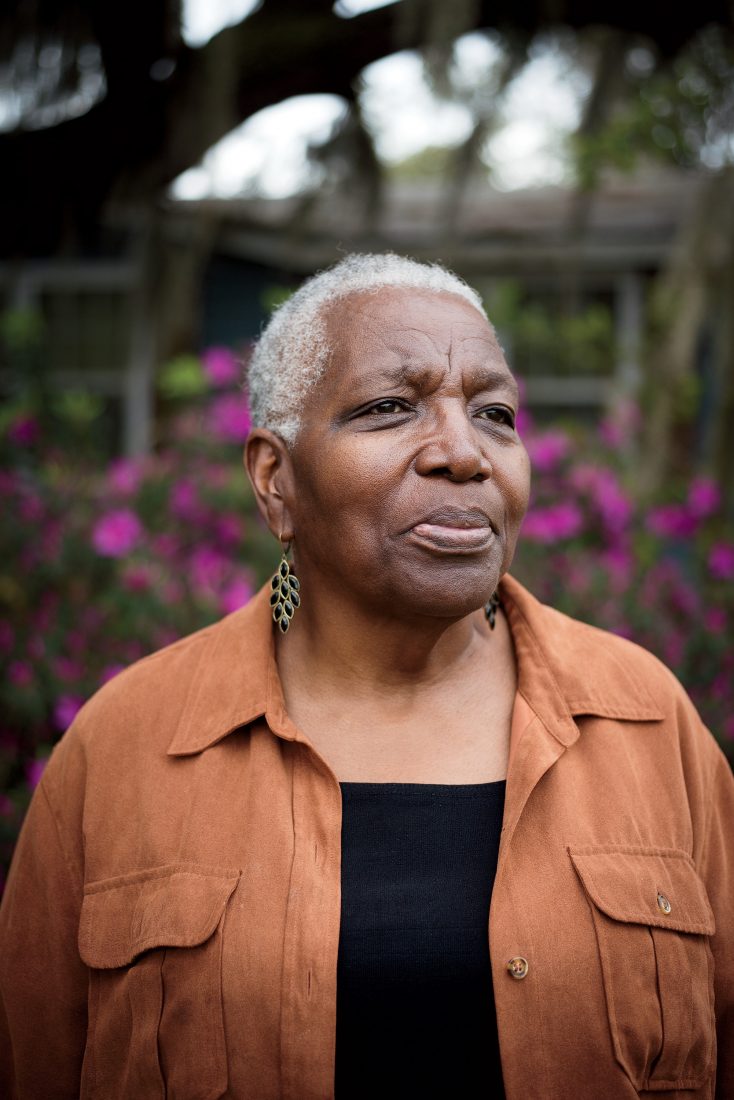
Photo: Imke Lass
Cornelia Walker Bailey sweeps her arm toward a forest of thick wire grass and towering loblolly pine. “In the past, all this was sugarcane field,” she says in a singsong patois that’s equal parts Deep South and West Indies. “My great-great-grandfather Alec Walker used to plant cane right there. My father as a little boy stayed with him, and his oxcart would carry a whopping load of cut cane from here in Hog Hammock all the way up to Chocolate. Then another whopping load. This is a big island, so you only had time to do two loads a day. That’s right.”
It’s not too difficult to picture that scene. On Georgia’s Sapelo Island, unlike nearly every other barrier island in the South, the primeval coastal landscape and a three-hundred-year-old African American culture endure, interwoven like strands of a wire-grass basket. Bailey is an author, innkeeper, shopkeeper, historian, farmer, and the island’s unofficial matriarch. She’s tall, with close-cropped gray hair and a hearty laugh. Her purple T-shirt reads DAUGHTER OF A FIELD NEGRO.
As a steward of the Sea Islands’ deep-rooted Gullah Geechee culture, Bailey, who is sixty-nine, bears the torch of Sapelo Island ancestors she can trace clear back to West Africa. She also shoulders a burden of history, fighting against powerful currents to ensure that families who live in Hog Hammock, now a shrinking community of around fifty, might cling to this place of their ancestors far into the future. It’s a prospect that has become increasingly daunting. In the last decade, real estate speculation helped spark a four- or fivefold rise in property taxes. There’s also little opportunity to make a living; the young move away, the old eventually pass away. Turning the tide means convincing beloved neighbors to remain on—or return to—this quiet outpost of forest, dune, sea, and salt marsh, and providing them a means to do so. Saving Sapelo’s last permanent community may be a long shot, but Cornelia Bailey is no quitter. She and others who are committed to preserving Hog Hammock’s distinctive culture have been plotting a new future for Sapelo. This summer, sugarcane—a plant no one has grown commercially here in a hundred years—will join heirloom Sapelo red peas on the land Bailey’s forebearers worked long ago, part of a grander vision to reverse the settlement’s fortunes by looking to the island’s agricultural past.
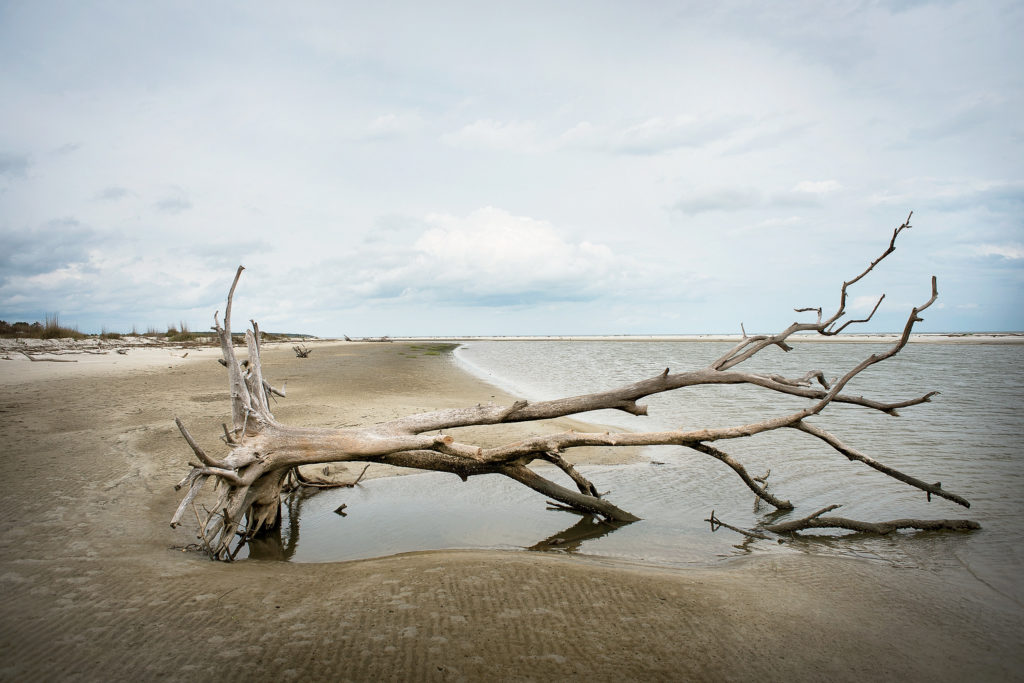
Photo: Imke Lass
Sapelo’s Cabretta Beach
Separated from the mainland by the nine-foot tides and big water of Sapelo and Doboy Sounds, Sapelo Island is reached only by boat, typically a twenty-minute ride aboard a Department of Natural Resources ferry from a landing near the tiny seaport of Darien. Sapelo is less known than nearby barrier islands such as Tybee, St. Simons, and Jekyll, but at eleven miles long and with 16,500 protected acres, it’s Georgia’s fourth largest. Its shore is home to miles of empty beach, whose blinding white dunes rival those of Pensacola. On its inland reaches, borders between land, marsh, and sound blur; open water gives way to bottomless pluff mud and seven-foot-tall spartina grass. Farther in, slightly elevated islands called hammocks indicate the transition to higher ground with salt-stunted oaks and scrubby saw palmettos. A dense line of trees rooted in sandy soil marks Sapelo proper: a surreal landscape of pine-shadowed wire-grass savannas, open fields, and an impenetrable riot of Spanish bayonet, bay, holly, and palmetto, all lorded over by venerable live oaks with wizard beards of thick Spanish moss.
Nearly every coastal animal species in the South lives here. White and brown shrimp and fiddler and blue crabs feed redfish, which in turn feed ospreys, southern bald eagles, wood storks, sharks, and bottlenose dolphins. The pluff mud supports clams and huge banks of oysters, their beds delicately trodden by white ibis, snowy egrets, and great blue herons, a bird islanders call “PoJo”—“Po” because they look skinny and impoverished, “Jo” because they resemble everyday working joes. Alligators lurk in freshwater, and wild hogs and huge Brahma bulls roam forests. “Two thousand pounders,” Bailey says. “Cumberland has its wild horses, Ossabaw has pigs and donkeys. We’ve got wild cows.”
Sapelo’s wild landscape appears timeless, but its only real constant is change. When Spanish missionaries arrived, in 1573, they subjugated the local Native Americans and christened the island Zapala, which seems to have morphed into its current moniker. In 1762, European planters appeared, along with slaves: first English colonists, then a consortium of French noblemen who divided the island into parcels—Chocolate, Bourbon, Raccoon Bluff. Through decades of hardship, Sapelo’s enslaved African population grew and endured. “Historians say the French planted three to four hundred acres to sustain themselves,” Bailey says. “How the hell are three or four Frenchmen going to plant four hundred acres? We were the ones who planted those acres.”
Photo: Imke Lass
Traditional Sapelo Island red peas.
1 of 8
Photo: Imke Lass
The island’s sour oranges are ideal for marmalade.
2 of 8
Photo: Imke Lass
Cornelia Bailey near her home in Hog Hammock.
3 of 8
Photo: Imke Lass
Nearly every coastal animal species in the South lives on Sapelo, including many varieties of shore birds.
4 of 8
Photo: Imke Lass
This year surgarcane—a plant no one has grown commercially here in a hundred years—will join heirloom Sapelo red peas on the land Bailey’s forebearers worked long ago.
5 of 8
Photo: Imke Lass
6 of 8
Photo: Imke Lass
Sapelo Island is separated from the mainland by the nine-foot tides and big water of Sapelo and Doboy Sounds.
7 of 8
Photo: Imke Lass
Spanish moss on Sapelo.
8 of 8
Beginning in the early 1800s, much of Sapelo came into the hands of an American named Thomas Spalding. Backed by hundreds of slaves, Spalding transformed it into a hub of Sea Island cotton, rice, and the young nation’s first sugarcane crop, a hardy species called Purple Ribbon. The earliest ancestor Bailey can directly trace through her bloodline was Spalding’s slave foreman, a tall, regal African Muslim she calls Bilali and Sapelo historian Buddy Sullivan refers to as Bul-ali. Although Spalding worked his slaves as hard as any plantation owner, he allowed them a degree of self-determination that led other planters to deride the island as “nigger heaven.” He even armed slaves to defend against the British in the War of 1812. Up until the Civil War, this Bilali-overseen empire of cotton and sugar flourished. Spalding also loved oranges, and the remnant trees and their sour fruit still dot the landscape.
War and hurricanes eventually cast much of Spalding’s plantation kingdom into ruin. In time his heirs sold much of their land to speculators and descendants of Spalding’s slaves, who by the twentieth century numbered nearly a thousand. “They were virtually on their own,” Bailey says. “Took care of themselves, planted for themselves. There was no white man directly calling the shots until Howard Coffin [a founder of the Hudson Motor Car Company] came down from Detroit in the early 1900s. He hired a lot of people here. Redug canals, cut timber, started an oyster factory and regular boat service. He put money in people’s pockets.” Coffin restored the old Spalding mansion in palatial style, and in the 1920s Charles Lindbergh, the Coolidges, and the Hoovers came to visit.
In 1934, Coffin sold his holdings to R. J. Reynolds, Jr.—the son of the tobacco magnate, who remained in charge when Bailey was born eleven years later; her father worked for him as a land steward. “No one particularly liked Reynolds,” she recalls. In the fifties and sixties, Reynolds consolidated the island’s black population to Hog Hammock, which became Sapelo’s largest and eventually only black community. He built a school there, and invited marine scientists to help him launch what would become the University of Georgia Marine Institute, which spurred the nascent study of ecology and remains active on the island’s southern end.
Bailey grew up with a brother, sister, niece, and nephew in a simple wooden cottage with no telephone or electricity. Her father sewed cast nets, built traps, and recast empty bullet and shotgun shells—loading the cartridges with nails to hunt deer. Her mother was a skilled fisher and farmer who ground her own grits. Life was ruled by nature, God, and Dr. Buzzard, a Geechee name for the local practitioner of voodoo—Sapelo’s was a woman Bailey refers to as “Mama Lizzie.” If you wanted to know the future or hex a neighbor, you called on Mama Lizzie for a potion or a spell.
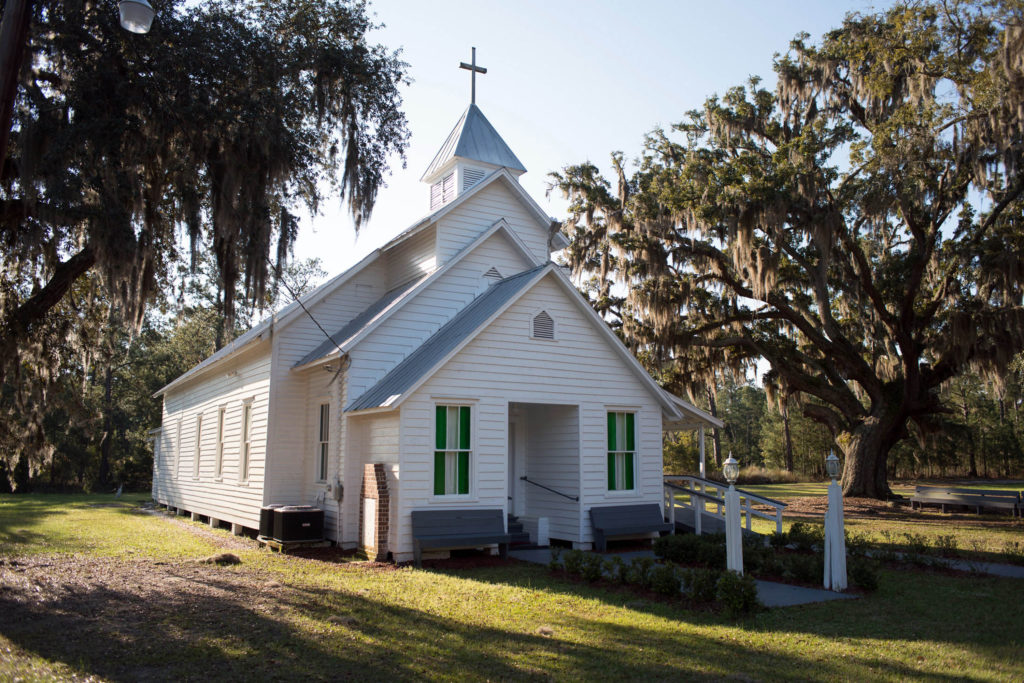
Photo: Imke Lass
Located on Sapelo, St. Luke Baptist Church will observe its 131st anniversary this year.
Bailey herself has long been a revered figure in the community. One day when she was three, she and her brother Asberry picked and ate some unripe pears, and she became dreadfully ill. As the sun rose the next morning, she says, she died. A pine coffin was built. Wailing relatives laid her out in her frilly church dress; neighbors prepared to gather for her funeral. But her aunt Mary wasn’t quite convinced. “She crushed up a bunch of garlic and stuffed it up my nose and put it all over me,” Bailey says. “And it worked. I woke up.” From then on, Sapelo’s elders looked at Cornelia differently. She had a shine. Her relatives believed that she could sense spirits, and that she had been resurrected for a higher purpose.
On a sunny day in Hog Hammock, the fruits of Cornelia Bailey’s purpose are in plain sight. Clustered together in the village’s center sit her broad-porched guesthouse, called the Wallow; the family’s tiny store (the Graball) and bar (the Trough); the modest wood-frame home where she and her husband, Julius, raised their five children, along with some twenty foster and adopted children; and the headquarters of the Sapelo Island Cultural and Revitalization Society, SICARS, whose founding she spearheaded. Three grandkids tear around on bicycles. Only seven young children live here; since Sapelo’s school closed in 1978, they ride the ferry to classes on the mainland. On Sapelo, everyone looks out for them. No one locks their doors.
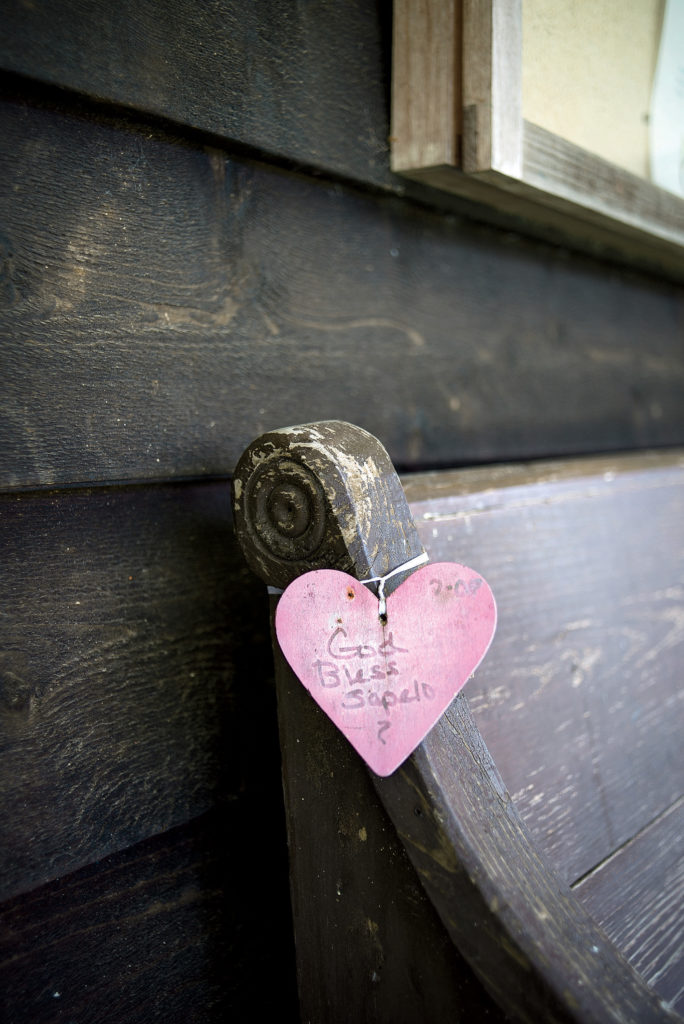
Photo: Imke Lass
Island Love
A bench on the porch of Bailey’s guesthouse, the Wallow.
Residents of Hog Hammock, which is on the National Register of Historic Places, at one time lived solely in fifty or so colorful but modest, hand-built, tin- and tar-paper-roofed homes, framed by grand oaks and spacious garden plots. Most of those old houses remain, though several have fallen into decay or been replaced with trailers or larger houses as families outgrew them. With the exception of “the autobahn”—a ribbon of pavement that leads to the ferry dock—roads are dirt and mud. When cars on Sapelo give up the ghost, they tend to slowly rust into the landscape.
Visitors are welcome here. Tourism is one of the few means locals have of earning a living on the island, although for a long time outsiders were, understandably, viewed with suspicion. By 1976, the Reynolds family had sold most of the island to the state of Georgia, ushering in decades of mistrust. Many islanders thought sloppy deeds were executed. “The state, the Reynolds board, nobody bothered to talk to us about it, or to ask us, ‘Do you think you might still own land outside of Hog Hammock?’” Bailey says. “Then we learned, through word of mouth, that they planned to buy out all of Hog Hammock and move us into a new subdivision in Darien. I actually saw the map in the state office. It had a big red circle around Hog Hammock that said TO BE ACQUIRED. That’s right, we’re not even supposed to be here.” She describes Hog Hammock as “four hundred thirty-four private acres in the middle of a huge nature preserve.”
Sapelo’s unspoiled beauty remains intact, and after a bruising legal battle, matters between islanders and the state settled into a truce. The downside: Aside from working for the state or university, jobs are scarce. Some plots were sold to people from “off,” though Bailey says the development fever that once had speculators jumping off the ferry with Hog Hammock maps, asking locals to sell, has for now abated—thanks in part to the recession, strict building regulations, and local mistrust of developers “who speak with forked tongues.” Bailey points to a hulking mini-mansion that was abandoned and sits decaying in the woods. “We call that one the Tower of Babel,” she says. But it’s become clear that Hog Hammock cannot prosper—or even survive—in strict isolation, and people from elsewhere have joined Bailey in her quest to preserve the community and the culture that still endure here: their language, arts, crafts, folklore, food, and history.
One of these is Dr. Bill Thomas, a fifty-four-year-old pathologist of Geechee descent who grew up in Charleston and up and down the East Coast. Thomas now lives near Atlanta and has become a fixture on Sapelo. “Doc Bill” and his wife, Annita, first visited Sapelo in 2000, and soon fell in love with the island and the Baileys. As the first African American from off in recent memory to own land there, he worked hard to gain islanders’ trust. “I like to say he’s my oldest son,” Bailey says.
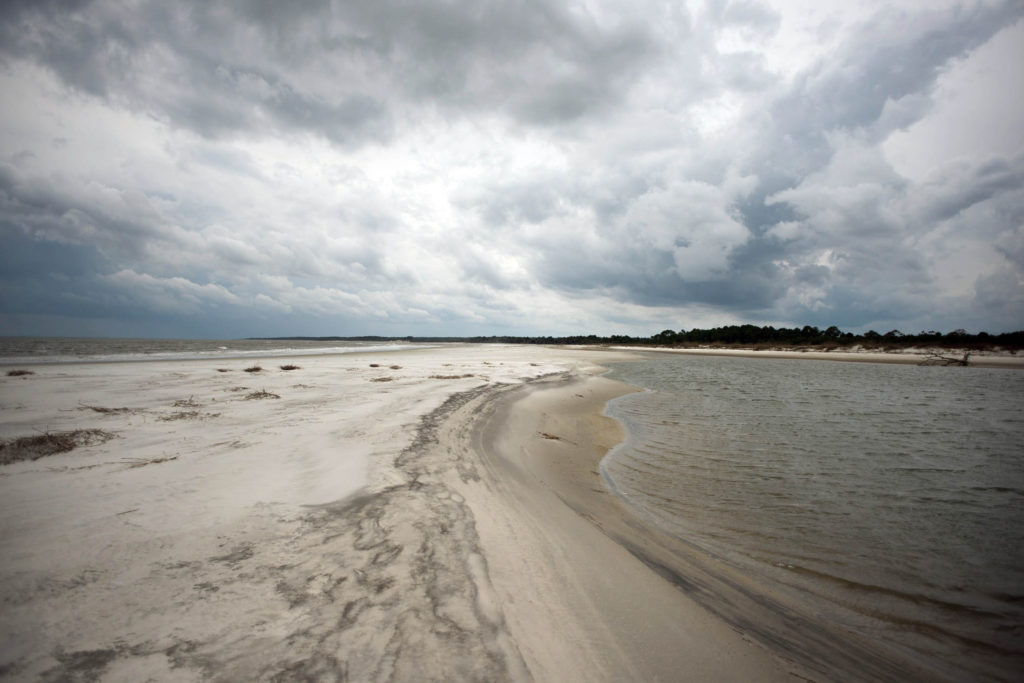
Photo: Imke Lass
At eleven miles long with 16,500 protected acres, Sapelo is Georgia’s fourth largest island.
A few years ago, Bailey, Thomas, and members of SICARS launched an informal partnership. Thomas renovated Sapelo’s tiny country store, BJ Confectionary, and sank a sizable sum into gorgeous rental cottages called the Sapelo Island Birdhouses, the revenue from which he plows back into the community. He helped find backing for the Baileys’ golf-cart rental business, which enables visitors to roam the island’s south end. In 2013 Bailey supported inviting to the board of SICARS a longtime white landowner named Lloyd Newberry, the former dean of education at Savannah’s Armstrong State University and a passionate outdoorsman. Bailey makes it clear that she wants Sapelo’s African-influenced culture preserved; when white people take an interest in supporting that, so much the better.
“Our whole purpose with SICARS is to keep the bloodlines of the descendants on that island,” Newberry says. “Why did I build a place out here? The people of Hog Hammock. I love being around them, and hearing the old stories. Oh, and the food. Nobody smokes better ribs than Tracy Walker; nobody cooks better deviled crabs than Yvonne Grovner or bakes better fruitcakes than Josephine Walker.”
It was food, in fact, that sparked a big idea. In 2012, Bill Thomas, who has edited and coauthored Cherokee and Sapelo Island cookbooks, posted a series of YouTube videos about Sapelo cooking. Soon afterward, Thomas tells me as we chat in the Baileys’ kitchen, he received a call from the Atlanta chef Linton Hopkins, of Restaurant Eugene and Holeman & Finch. “We gotta talk,” Hopkins said.
Thomas hands me a cloth bag printed with a logo: SAPELO ISLAND GEECHEE RED PEAS. “I told Cornelia, ‘I have a friend who wants to buy some of your red peas,’” he says.
“It was just from a small field we plant,” Bailey says. “I sat in that chair right there and my husband sat right there, or under a tree, and we’d shell them.” She could hardly believe it when Thomas hand delivered Hopkins’s first check for twelve pounds of red peas. The same year, the Baileys sold peas to customers as distant as California and Maine. “Word got out,” she says, chuckling. The Baileys cleared five acres for this summer’s harvest, and ordered a shelling machine.
“They’re a real dark purple,” Hopkins later told me, “and the cooking liquid, the potlikker that comes off them, it’s so flavorful. The skin pops, and they’re creamy on the inside. I love the idea that eating a bowl of peas is filled with so much positive energy of that person and that place.”
Photo: Imke Lass
Bailey holds Sapelo red peas.
1 of 5
Photo: Imke Lass
Island oranges.
2 of 5
Photo: Imke Lass
Dr. Bill Thomas with a stalk of sugarcane.
3 of 5
Photo: Imke Lass
Dolls made by a local artist.
4 of 5
Photo: Imke Lass
Two of the Sapelo Birdhouse Cottages.
5 of 5
Now an even more ambitious project is percolating, a brainchild of Thomas, the cuisine revivalists David Shields (of the University of South Carolina) and Glenn Roberts (of the heirloom grain producer Anson Mills), and Stephen Kresovich, a Clemson geneticist. Last year, they began a search for seed stock for Purple Ribbon, the original sugarcane grown on Sapelo, hoping, as Shields puts it, “to de-extinct this species by back-breeding it.” After querying seed banks and botanical labs, they gathered enough seeds for a spring planting at Thomas’s Coastal Georgia Gourmet Farms, in nearby Shellman Bluff—some from cane Bailey’s neighbors have grown for generations, some from as far away as Mississippi and the Caribbean. When they see which cane does best, they’ll transplant grown stalks to Sapelo late this summer. And with them, the potential of an heirloom brand of Sapelo Island sugar—which might be produced on a scale to put Hog Hammock on the culinary map, and perhaps even return some long-dormant grassy fields the Department of Natural Resources owns to cultivation.
And there could be more ahead. On his farm, Thomas is also growing turmeric, Thai limes, and ginger, all well suited to Sapelo’s climate and soil. “We want to utilize the Georgia coast to grow things you can’t in Atlanta, or anywhere else,” he says. Thomas, Shields, and Newberry all point out that by combining Sapelo clams, oysters, and mussels with red peas, sour oranges (which are ideal for marmalade), muscadines, and sugarcane—made into syrup, crystals, or rum—you could assemble a Sapelo-centered, island-to-table cuisine. “It fits the culture of today,” Newberry says. A Sapelo food-ways revival would also fit the overarching goal: to give islanders and their descendants a means to keep their land, a reason to stay.
“There’s no dress rehearsal with this,” Thomas says, alluding to the recent land battles. “If we don’t get it done, things are going to be tough. Because others have plans for what will happen on Sapelo. Some young people want to leave the island, but some don’t. The woman who works for us at the Birdhouses is Cornelia’s niece. She loves it here. She can fish, dig clams, and be on the beach with her child. It’s a lifestyle you don’t find on the mainland, and there are young people who want that.”
And hardworking elders leading the way, like Cornelia Bailey. “Her influence is why so many have stayed out there today,” Newberry says. “She’s given everyone a reason for hope.”
Inside her house, Bailey shows me black-and-white photos on her wall: a portrait of one relative, Betsy Walker Gardner Bailey, that looks straight out of Gone with the Wind; a shot of a relative named Katie Brown, who in the 1930s was interviewed for a book about Gullah Geechee culture called Drums and Shadows. “Then in this picture we have Charles Hall, Alma Johnson Dixon, Flora Hillary Johnson,” Bailey says. “They’re all gone. Only Ben, who is seventy-nine, is left.”
She pauses for a long moment. “We’re hinging all this work on the idea that it will help bring young people back home,” she says. “The whole reason we’re doing this is because we want people to come back.”




















